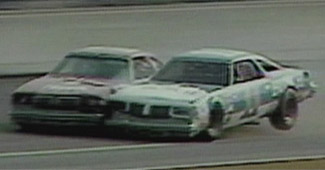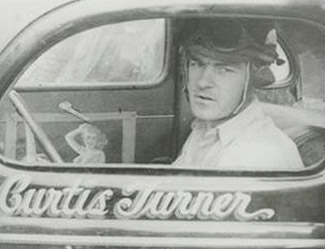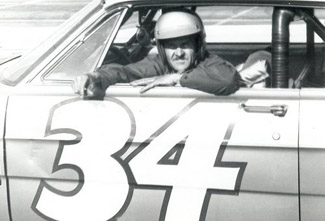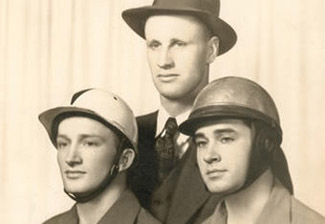
Brandon Reed
By Brandon Reed
Posted in Columns 1/14/11
The snowy weather that bogged down the southeast over the past week really limited the number of things you can do to pass the time.
One of the best things you can do, however, is to get caught up on your reading. I have a pretty good stack of books that I need to go through, and the frozen conditions outside of my house opened up the opportunity to do just that.
I’m currently half way through what has proven to be a very interesting and well-put together book on the 1979 NASCAR Winston Cup Season by Mark Bechtel called He Crashed Me So I Crashed Him Back.

The 1979 season, including the infamous last lap of the Daytona 500, is the subject of Mark Bechtel's book "He Crashed Me So I Crashed Him Back."
Bechtel works his way through the start of the 1979 season, spending well over half of the book on the lead up to and running of the 1979 Daytona 500. He manages to introduce us to all the main players, give us their background, as well as the background of the sport in a breezy, fresh manner, employing the use of quick, handy footnotes to fill in the gaps for new comers while not boring long-time fans with the same old stories we’ve heard a hundred times.
From the beginning of the season, with the marriage of Kyle and Pattie Petty, to the last lap crash in the Daytona 500 between Cale Yarborough and Donnie Allison, Bechtel manages to not only keep you interested, but even pulls out a few notations and stories that I hadn’t heard before.
With that in mind, here’s a look at a few more auto racing books that are must reads, in my opinion. In fact, I’ll go so far as to say that, of the auto racing books I’ve read over the years, these are the top three (in no particular order).
Full Throttle: The Life & Fast Times of Racing Legend Curtis Turner by Robert Edelstein – The name pretty much says it all. There has likely never been a driver that was the subject of more stories, tall tales and general legend.

It had been said many times over the years that Curtis Turner's exploits would fill a book. Robert Edelstein finally proved that with his account of the life of one of racing's greatest throttle stompers.
In this book, which was long researched and extremely well written, Edelstein explores all the myths and tall tales of Turner’s life and career, beginning with his days as a second-generation bootlegger in the hills of Virginia to his beginnings as a stock car jockey. Of all the NASCAR heroes over the years, Turner was the most revered and most talked about. And many of the stories proved to be true! Edelstein shows us the man behind the myth, the life behind the parties, from his early days racing on bullrings around the south to his struggles to keep Charlotte Motor Speedway, a track that he built, in his control, to his banning from NASCAR due to his attempts to unionize the drivers.
Edelstein also takes a rare glimpse at Turner’s death, asking questions about how much of the legend surrounding the plane crash that claimed Turner’s life was actually his fault.
The book came out 2005, but is still readily available in both hardback and paperback.
Hard Driving: The Wendell Scott Story by Brian Donovan – This is a book that was long overdue and much anticipated by racing fans and historians all over. For the first time, and author tackled the tumultuous story of Wendell Scott, the only African-American to compete on a regular basis and to win an event on the NASCAR Grand National (now Sprint Cup) tour.

Wendell Scott's story was finally told by author Brian Donovan in the book Hard Driving.
Donovan went to great lengths with the research on this book, and it shows. Scott’s story is one of determination, disappointment but in the end, personal triumph.
The great thing about this book is that Donovan tells Scott’s story warts and all, not sugar-coating it to make anybody look good or to look bad. He exposes the hypocrisy seen by members of the NASCAR community during Scott’s career, both in the way of NASCAR officials, track owners, promoters and fellow competitors.
But where Donovan exceeds is in the way he tries to tell both sides of a story. Rather than just opting to take the story to strengthen the character of the subject or to build sympathy, he gives the other side of the story a chance to be told. In several instances, he gives both the subject and the alleged protagonists the chance to tell their side, therefore giving a well-rounded story and allowing the readers to make up their own minds.
Donovan comes away with a true story of a true pioneer and hero, along with a look at the times Scott had to deal with. You don’t know how good you have it until you see what Wendell Scott had to work with.
As an added bonus, one of GRH.com’s own is part of the book. Mike Bell and his father were present at the NASCAR Grand National race at Jacksonville, Florida when Scott won his first and only top tier event. The race was originally given to Buck Baker, but Bell and his father stayed after everyone else had left to hear the result of Scott’s protest. Bell tells the story of what happened after everyone else went home.
The book came out in 2008, and is still available in hardback or paperback.
Now, to be honest, I feel I’ve saved the best for last.
Driving With The Devil: Southern Moonshine, Detroit Wheels and the Birth of NASCAR by Neal Thompson – If there was ever a book about auto racing that NEEDED to be written, this is the one.
Neal Thompson’s book tells the true story of the birth of modern stock car racing, centering on the life story of the late Raymond Parks, and beginning with his childhood in rural Dawson County, Georgia. From there, we learn about other key players in the beginnings of the sport, including master mechanic Red Vogt, moonshine trippers turned race drivers Lloyd Seay and Roy Hall, war veteran and champion race car driver Red Byron and enterprising businessman Bill France Sr.

Driving With The Devil tells the story of the men who helped build modern stock car racing, including Raymond Parks (back), Lloyd Seay (left) and Roy Hall (right). All three are now members of the Georgia Racing Hall of Fame.
But the story isn’t about racing. It’s about the lives of these men who happened to become involved in racing. It’s not really a NASCAR book. It tells the story of what happened leading up to the formation of NASCAR. But make no mistake, without the men profiled in Driving With The Devil, there would be no NASCAR today.
Thompson tells the stories warts and all, not letting a good story get in the way of the truth.
It’s a story that many of us thought would never be told. Fortunately, Thompson did the work to research the real stories rather than the whitewash PR garbage usually handed out, and the result is what many consider to be the best book written about the history of the sport.
To make no bones about it, I consider Driving With The Devil to be the most important book regarding the history of modern stock car racing, and anybody who wants to know where the sport really came from needs to have this book on their shelves.
It was originally published back in 2006, and is easily found in both hardback and paperback. In fact, you can get paperback copies from the Georgia Racing Hall of Fame in Raymond Parks’ hometown of Dawsonville, Georgia if you visit there.
That’s my “must have” list. Mind you, I’m sure there are others out there that may rivals these, and I look forward to reading them some day. But preferably one with a little less snow.
Brandon Reed is the editor and webmaster of Georgia Racing History.com.
Questions, comments, suggestions? Email us!
This website is not affiliated with or endorsed by the Georgia Racing Hall of Fame or the Georgia Auto Racing Hall of Fame Association, Inc. All content is the intellectual property of the individual authors. All opinions are those of the individual authors. Please do not repost images or text without permission.
